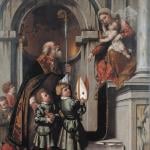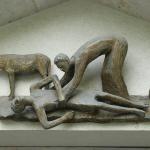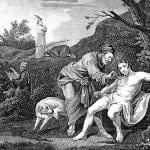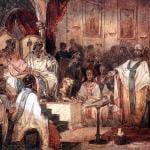REVELATIONS. Last night I finished my travel reading: Scott Hahn’s Lamb’s Supper: The Mass as Heaven on Earth (borrowed from the Oligarch). It’s a terrific book–“reads” the Mass through the Book of Revelations, and vice versa. Read it! It’ll illuminate one of the Bible’s wildest books, and, simultaneously, it’ll illuminate the Mass we attend (at least) every week. Ignore the cutesy pun-titles (“Oath Meal”–sigh); the book is solid.
In New York, I went to the “Time to Hope” show of Spanish Catholic art, on display at St. John the Divine Episcopal Church. I hope to review the show itself for publication, so for now you just get a capsule review: Go. It’s a treasure trove. The show is roughly organized into themes, so you’ll have, for example, a room dedicated to depictions of the “Ecce Homo” (one of these was the most powerful work in the entire show, for me–a statue of Christ, scourged and dressed in the mocking “kingly” robe–but if you looked closely, the artist had carved the Agnus Dei on the cloak–really intense); or a room dedicated to depictions of the Immaculate Conception (Mary as Revelations’ Woman Clothed with the Sun) and the Crucifixion. Pretty much all the art had the tactile, sorrowing, rawly physical quality everyone associates with Spanish Catholicism. The dates ranged from the 12th century (a small but striking statue of King David with musical instruments) through the Renaissance. The show was part of a series called “The Ages of Man,” and so there was an intellectually stimulating contrast between secular and Christian humanism–how do we know what man is, what we are? Is it art that we’re trying to live up to (which seemed to be the show catalog’s position), or Christ (which was the position of the art itself)?
The church in which the show was housed is a grab-bag, a big vaguely Christian attic. Representations of the Platonic forms, nooks honoring Gaia (whuh?), a plaque commemorating the Declaration of Independence (ohhhkay), and, tucked away where I wouldn’t have seen it if I hadn’t been seeking the restrooms, a terrific statue of the Return of the Prodigal Son. The contrast between the church (whose brochure proudly noted that its stained-glass windows did not depict “just” religious scenes, but also an early television [could I make that up?], Michelangelo carving the David, and other random stuff I forget) and the intensely Christ-focused, Heaven-directed art could not have been greater.











